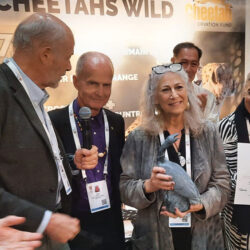CCF Study Examines Cheetah Preferences in Playtrees
-

- by CCF Staff September 8, 2016
FOR IMMEDIATE RELEASE
Cheetah Conservation Fund Study Examines Cheetah Preferences in Trees Used To Communicate Through Scent-Marking
OTJIWARONGO, Namibia (8 Sept, 2016) – A Cheetah Conservation Fund (CCF) study published in late August in Global Ecology and Conservation offers new insight on the spatial structuring of Namibian cheetahs. Scent-post preference of free-ranging Namibian cheetahs by lead author Eli Walker, examines the species use of olfactory communication to send messages via scent marking, with researchers attempting to determine why cheetahs choose certain trees to mark rather than others. In Namibia, these trees are known as “playtrees” or “newspaper trees.”
“Cheetahs are known to have large, overlapping home ranges, and scent-marking behavior supports the notion cheetahs are using a time-share approach to territorial spacing,” said Dr. Laurie Marker, Founder and Executive Director of CCF. “This system allows multiple cheetahs to use the same general area while reducing the chances for aggressive or unexpected encounters with other individuals.”
The study is significant because until now, the subject of cheetah spatial structuring has been largely unexplored. CCF scientists can now better understand investigating behavior and scent-marking patterns and their relationship to home range size and habitat use by Namibian cheetahs. This additional research may corroborate understanding of intraspecific cheetah interaction in regards to scent-marking, and will incorporate available research tools, such as scat detection dogs and genetic analysis.
CCF relies on the findings of its research to form the basis for its effective strategies to conserve the wild cheetah. When CCF was established in 1990, Namibia had approximately 2,500 wild cheetah, and today, that number is actually closer to 3,500. This is a 180-degree turn from just a few decades ago, when Namibian cheetahs were disappearing at the rate of several hundred each year during the 1970s and 1980s, largely due to unchecked conflict with livestock and game farmers.
CCF strategies to mitigate human-wildlife conflict include farmer education and training in non-lethal predator control techniques. CCF’s vocational agriculture training course, Future Farmers of Africa, has certified more than 5,000 Namibian men and women in integrated wildlife and livestock farming techniques. The course provides basic information on animal husbandry, vaccinations, hoof care and calving strategies, and extends into integrated livestock/wildlife farming techniques designed to reduce chances for conflict. The course includes training in the use of a CCF Livestock Guarding Dog, a specially trained dog bred to work with livestock farmers in rocky, arid terrain. Farmers in Namibia using a CCF Livestock Guarding Dog report an 80 to 100 percent drop in losses due to predation, making it the singular most valuable tool farmers have to reduce conflict.
The cheetah remains the most endangered big cat in Africa. Its numbers have dropped from a total population of 100,000 approximately 100 years ago to less than 10,000 today. Namibia has the greatest density of wild cheetah, with an estimated one-third of remaining wild cheetahs living within its national borders. Cheetah Conservation Fund works to conserve the wild cheetah throughout its range, with a particular focus on the Namibian cheetah, to fortify the last wild cheetah stronghold.
Camera trap photo of cheetahs at a playtree, taken during the scent study period. Camera traps and the photos taken are important tools that help scientists gain insight into species behavior.
Contact:
Dr. Laurie Marker – Namibia
[email protected]
067 306225 or 0811247887
Susan Yannetti – USA
[email protected]
(202) 716-7756
Cheetah Conservation Fund
Cheetah Conservation Fund (CCF) is the global leader in research and conservation of cheetahs. With field headquarters in Namibia – ‘The Cheetah Capital of the World’ — CCF is dedicated to saving the remaining strongholds of cheetah populations in the wild. CCF believes that understanding the cheetah’s biology, ecology and interactions with people is essential. CCF’s strategy is a three-pronged approach integrating research, conservation and education, beginning with long-term studies to understand and monitor the factors affecting cheetah survival. Results are used to develop conservation policies and programmes, many of which include helping human populations that live alongside cheetahs. CCF works with local, national and international communities to raise awareness, communicate and educate people about the species. CCF also provides training in a number of fields to help develop livelihoods for rural Namibians.
Related Reading


